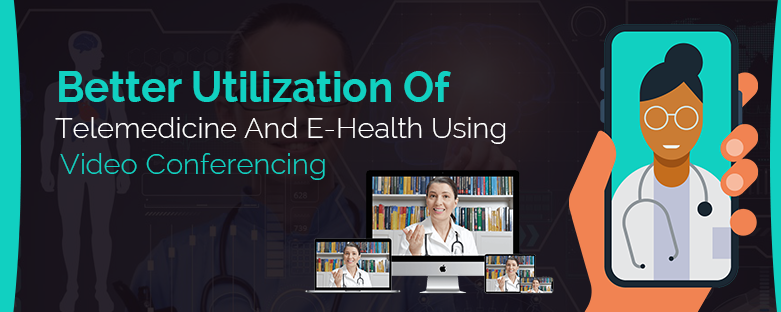Telemedicine And E-Health Using Video Conferencing
Telemedicine app development has started to transform the healthcare industry. Telemedicine software development is now the primary goal of healthcare organizations wishing to provide patients with healthcare facilities from a distance. Telemedicine and e-health software is a perfect option when it comes to routine checkups or dealing with patients who have trouble getting to their appointments either through a lack of transportation options or mobility issues.
In mitigating the spread of infection and protecting your patients from virus exposure, it has also become an important factor. Telemedicine and e-health is treating a patient without the physician meeting the patient in person. By using live images, audio, and also transmitted to the patients their diagnosis
Patients may not need to be in the same place as their doctor or specialist to obtain treatment by using video conferencing and other telehealth technology. The waiting room game of attempting to see their doctor at an appointed time is also not important for patients to play. When remote video technology is used to perform a visit, transportation ceases to become a problem. These advantages are particularly important for low-income patients and elderly people who find it difficult to visit many doctor’s offices or specialists, and hourly employees who cannot afford to take time off work to drive to an appointment and wait for it.
What is Telemedicine
Telemedicine is a tool for making services more accessible, cost-effective, and enhances patient engagement. Telemedicine has advanced significantly since its inception in the late 1950s, allowing elders to age in place. Furthermore, patients in rural areas who previously had difficulty accessing a physician can now contact them virtually.
Doctors and patients can transfer information from one computer screen to another in real time. They can even view and record data from medical devices that are located in another area. Patients can see a doctor for management and therapy without needing to book an appointment thanks to telemedicine software. Patients can consult a doctor from the convenience of their own homes.
What is E-Health
There has been considerable ambiguity regarding what eHealth is, and according to several eHealth descriptions, it is a broad phrase recently created to encompass everything linked to healthcare that is carried out utilising digital procedures and electronic communication. It’s used for more more only Internet Medicare; it’s also utilised to make pharmaceuticals and computers digitally. In general, e-words are used in a variety of fields, indicating the likelihood of the Internet expanding to other fields as well, resulting in the emergence of eHealth.
eHealth is more than just a technological advancement; it has greatly expanded the scope of healthcare. Because the expenses are lowered and the quality of therapy is improved, it leads to increased efficiency in the treatment of health. This is due to the large number of healthcare professionals available. It also enables for evidence-based treatment, as everything recommended over the Internet is based on scientific research rather than guesswork.
Benefits of Telemedicine and E-Health Using Video Conferencing
In the distance health industry, it’s still early, but the good news is that there is already a range of technologies in use and many opportunities and applications to serve patients using secure online video conferencing kiosks.
- Video conferencing may be consistent with the mandate for health protection requirements of the country. Not all major video conferencing solutions, however, can meet the 1996 Health Insurance Portability and Accountability Act (HIPAA) requirement, especially not big names in the industry such as Skype and Facetime.
- The professional referral method may also be expedited by video conferencing. A primary care or allied health care provider may consult with a patient or specialist using video, which allows them to arrive at a diagnosis and more quickly suggest a referral and more quickly recommend referral.
- Video conferencing may be used by health practitioners to expand their educational scope as well. For conferences, meetings, and even ongoing courses, students, fellow physicians, and patient advocacy groups may interact via video to exchange knowledge that would otherwise be out of reach for others.
- Video conferencing is a rapidly evolving and viable way of offering close-to-home educational (telelearning) and clinical care (telemedicine) opportunities for rural doctors.
- At any given time, medical professionals should not be in more than one location, except they can with healthcare video conferencing. Patients who may not be able to afford to fly to their location or are just very far from the treatment they need may provide their expert opinion and expertise.
- In crisis zones, video conferencing extends the effect of physicians, affecting those impacted by flooding, tropical storms, and more. Patients in these “hard to access” areas can communicate with doctors located anywhere quickly and easily by video calling. Some progressive school districts have collaborated with physicians to provide online visits where they can save time and determine the urgency of the situation. The ease of telemedicine and e-health often significantly helps to minimize the number of appointments missed or rescheduled.
- It can be tough to find the quality or nearby medical assistance in remote areas. Using technology, such as video conferencing or patient platforms online, will make healthcare more affordable and open to these patients.
- With video conferencing, you can communicate even more effectively and accurately with your patients. Video conferencing not only helps you to see the visual signals that are inherent as patients talk, but you can also interact with your patients wherever they are in person. As such, the interactions are more successful and reliable with your patients.
- Live outside the city limits makes it much more of a challenge for doctor visits in the city. The benefit of telemedicine video conferencing is that patients can get access to the clinicians they need in their time of need, within reason, and availability. In pediatrics, for example, there is a tremendous opportunity, as most children’s symptoms do not have to be diagnosed in person. By video conferencing, having the answers to questions restores peace of mind and saves a ride!
Conclusion
Millions of individuals could benefit from telemedicine and e-health, which allows them to get care on their own terms, whether at home, at work, or anywhere else. The legal foundation for top telemedicine software will improve in the future years, making it easier for healthcare practitioners to address the major telemedicine difficulties.
If you’re considering building or purchasing telemedicine software, VCDoctor is the place to go. Our telemedicine solutions providers a significant benefit. Our effective solution additionally provides a variety of telemedicine platform advantages for a fantastic experience. Give us a call right now!





The telemedicine platform can be an excellent initiative for better treatments in the future. The video conferencing feature is the best part of telemedicine because it provides facilities to see and communicate with patients. Informative post thanks for sharing.
I am curious about how telemedicine software does video conferencing, but I got my answer after reading this informative and excellent post.